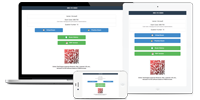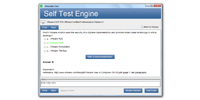덤프유효기간을 최대한 연장
C9520-923덤프를 구매하시면 1년무료 업데이트 서비스를 제공해드립니다.덤프제작팀은 거의 매일 모든 덤프가 업데이트 가능한지 체크하고 있는데 업데이트되면 고객님께서 덤프구매시 사용한 메일주소에 따끈따끈한 가장 최신 업데이트된 C9520-923덤프자료를 발송해드립니다.고객님께서 구매하신 덤프의 유효기간을 최대한 연장해드리기 위해 최선을 다하고 있지만 혹시라도 IBM WebSphere Portal 8.0 Deployment and Administration 시험문제가 변경되어 시험에서 불합격 받으시고 덤프비용을 환불받는다면 업데이트 서비스는 자동으로 종료됩니다.
IT 업계의 선두자로서 저희의 목표는 IT인증시험에 참가하는 모든 분들께 도움을 제공해드리는 것입니다. 이 목표를 달성하기 위해 저희의 전문가들은 시간이 지날수록 쌓이는 경험과 노하우로 IT자격증시험 응시자분들을 지원하고 있습니다.덤프제작팀의 엘리트들은 최선을 다하여 근년래 출제된 IBM WebSphere Portal 8.0 Deployment and Administration 시험문제의 출제경향을 분석하고 정리하여 가장 적중율 높은 C9520-923시험대비 자료를 제작하였습니다.이와 같은 피타는 노력으로 만들어진 C9520-923 덤프는 이미 많은 분들을 도와 C9520-923시험을 패스하여 자격증을 손에 넣게 해드립니다.
자격증의 필요성
IT업계에 종사하시는 분께 있어서 국제인증 자격증이 없다는 것은 좀 심각한 일이 아닌가 싶습니다. 그만큼 자격증이 취직이거나 연봉협상, 승진, 이직 등에 큰 영향을 끼치고 있습니다. C9520-923시험을 패스하여 자격증을 취득하시면 고객님께 많은 이로운 점을 가져다 드릴수 있습니다. 이렇게 중요한 시험인만큼 고객님께서도 시험에 관해 검색하다 저희 사이트까지 찾아오게 되었을것입니다. C9520-923덤프를 공부하여 시험을 보는것은 고객님의 가장 현명한 선택이 될것입니다.덤프에 있는 문제를 마스터하시면 IBM WebSphere Portal 8.0 Deployment and Administration 시험에서 합격할수 있습니다.구매전이거나 구매후 문제가 있으시면 온라인서비스나 메일상담으로 의문점을 보내주세요. 친절한 한국어 서비스로 고객님의 문의점을 풀어드립니다.
시험대비자료는 덤프가 최고
처음으로 자격증에 도전하시는 분들이 많을것이라 믿습니다.우선 시험센터나 인증사 사이트에서 고객님께서 취득하려는 자격증이 어느 시험을 보셔야 취득이 가능한지 확인하셔야 합니다.그리고 시험시간,출제범위,시험문항수와 같은 IBM WebSphere Portal 8.0 Deployment and Administration 시험정보에 대해 잘 체크하신후 그 시험코드와 동일한 코드로 되어있는 덤프를 구매하셔서 시험공부를 하시면 됩니다.C9520-923덤프구매전 사이트에서 일부분 문제를 다운받아 덤프유효성을 확인하셔도 좋습니다.저희 사이트의 영원히 변치않는 취지는 될수있는 한 해드릴수 있는데까지 C9520-923시험 응시자 분들께 편리를 가져다 드리는것입니다. 응시자 여러분들이 시험을 우수한 성적으로 합격할수 있도록 적중율 높은 덤프를 제공해드릴것을 약속드립니다.
최신 IBM Certified System Administrator C9520-923 무료샘플문제:
1. The business units of Mary's company have needs for their own portals. However, the demand on server resources is not great enough to require parallel installations. In response, Mary's company selected virtual portals. Which of the following options are available across each of the virtual portals by default?
A) Portal property file definitions
B) Document management
C) Anonymous pages per virtual portal
D) Portal search
2. Eric has an IBM WebSphere Portal 7.0 server with WebSphere Application Server 7.0 and IBM HTTP Server 7.0 installed in his production environment. He wants to install WebSphere Portal 8.0 in his production environment and wants to reuse the IBM HTTP Server 7.0 with WebSphere Portal 8.0 and WebSphere Application Server 8.0. How can he do that?
A) Eric needs to install a new instance of IBM HTTP Server 8.0 and WebSphere plug-in 8.0. IBM HTTP Server 7.0 and the WebSphere plug-in do not support WebSphere Application Server 8.0 and WebSphere Portal 8.0.
B) Eric needs to reconfigure the plug-in.xml file to point to the WebSphere Portal 7.0 and WebSphere Portal 8.
C) Eric only needs to configure WebSphere Portal 8.0 and WebSphere Application Server 8.0 with IBM HTTP Server 7.0.
D) Eric needs to install WebSphere plug-in 8.0 and configure it with IBM HTTP Server 7.0 and add the configuration to the WebSphere Application Server 8.0, which is running WebSphere Portal
8.0.
3. Which one of the following tasks is not required when configuring a property extension database in a single-server environment?
A) Run the ConfigEngine.bat wp-la-install-ear -DWasPassword=password.
B) Run ConfigEngine.bat wp-prep-vmm-db-secured-environment -DWasPassword=password.
C) Set the data source parameters in wp_add_LA.properties.
D) Set the DbDriver and DbLibrary parameters using wkplc_dbtype.properties.
4. At a high level, which of the following options best describes the sequence of steps that one should take when setting up an IBM WebSphere Portal static cluster?
A) 1.Use WebSphere Application Server Network Deployment to create a cell and managed node for each portal node in the cluster.
2.Use the WebSphere Portal cluster profile template to install WebSphere Portal onto each node.
3.Use the ConfigEngine tasks to configure the nodes to use the same database and user registy.
4.Federate each of these nodes into the cluster by using the addNode and ConfigEngine tasks.
B) 1.Install and configure WebSphere Portal as a stand-alone node for each cluster node.
2.Federate each portal server node to the WebSphere Application Server Network Deployment cell using the addNode command.
3.Create a portal cluster using the ConfigEngine tasks.
4.Configure the cluster members to use the same database and user registry.
C) 1.Use WebSphere Application Server Network Deployment to create a managed node for each portal node in the cluster.
2.Federate each of these nodes into the WebSphere Application Server Network Deployment cell using the addNode command.
3.Install and configure WebSphere Portal on each portal server node.
4.Use ConfigEngine tasks to configure the database, user registry, and create the cluster.
D) 1.Install WebSphere Portal on the first node, configure the database, and use the ConfigEngine tasks to create a profile template.
2.Prepare the first node to communicate WebSphere Application Server Network Deployment, and use addNode and ConfigEngine tasks to configure the cluster and user registry.
3.Install WebSphere Portal on additional nodes and use the profile template to configure.
4.Use the addNode and ConfigEngine tasks to federate the additional nodes and complete the cluster setup.
5. In which order is the rendering done when using modularized themes?
A) Markup JavaScript code Static JavaScript configuration Dynamic JavaScript configuration CSS
B) Static JavaScript configuration Dynamic JavaScript configuration JavaScript code Markup CSS
C) CSS Static JavaScript configuration Dynamic JavaScript configuration JavaScript code Markup
D) CSS Dynamic JavaScript configuration Static JavaScript configuration JavaScript code Markup
질문과 대답:
| 질문 # 1 정답: C | 질문 # 2 정답: A | 질문 # 3 정답: B | 질문 # 4 정답: D | 질문 # 5 정답: C |



 323 고객 리뷰
323 고객 리뷰





